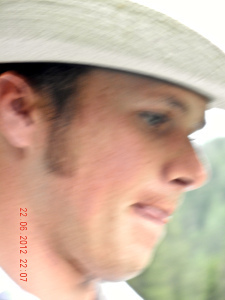Andrea Downing's Blog, page 14
May 1, 2014
Romancing the Vaquero
 Anne Schroeder writes about the West in short stories, essays and two memoirs, Ordinary Aphrodite and Branches on the Conejo. Cholama Moon is her first published novel. The second novel in the series, Maria Ines, will be released later in 2014, both by Oak Tree Press.
Anne Schroeder writes about the West in short stories, essays and two memoirs, Ordinary Aphrodite and Branches on the Conejo. Cholama Moon is her first published novel. The second novel in the series, Maria Ines, will be released later in 2014, both by Oak Tree Press.
She is President-Elect of Women Writing the West and chair of the LAURA Short Fiction Contest. She and husband Steve and their two dogs recently moved from Central California to Southern Oregon in search of new adventure.
A screenwriter gave her great advice: Say it in two sentences or less, eat lots of red licorice, network with unlikely people on their way up and produce quality stuff with no personal drama.
Allow me to introduce myself. I’m Anne Schroeder. I married my husband because I grew up reading Zane Grey and decided I wanted a cowboy. We’ve been married a bazillion years, but that’s another story. .
I’ve always had a fondness for Westerns, but they were mostly written for men and seemed to have only three main female characters, the stoic ranch wife, the town whore and the delicious maiden. Not that I have anything against love. In fact, I wanted to ramp the heat a tad. Historical westerns, like all period romances, create a memorable boy meets girl love story within the grand landscape of the West, surrounded by authentic people, places and events. But always—always—there’s a good story between the covers.
Early on in my writing career I got some great advice. Write about what you know. I knew about:
1) hard work
2) love of family
3) wanting a bigger life
4) loving the hills outside my childhood home so much that I memorized the horizon
5) earthquakes
6) Missions
So I combined everything into a series set in a part of California I love, with vaqueros, banditos, Mission padres and proud women and men. Cholama Moon is the story of a young girl, one of the first white women in Central California. Maria Ines takes the Indian cook who tries to mother her in the first book, back to her birth in the conflicted Spanish Mission times. I’m still working on the third book
In Cholama Moon, my character Virginia, Ginny,
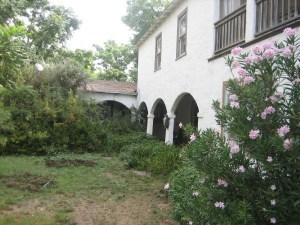
Casa Cholama, the inspiration for Ginny’s home in Cholama Moon (Located in the Cholama Valley, CA)
is pretty much alone since her mother’s death when she was three, and her father’s descent into opiates, common in the day. Ten years later they each blame themselves for Mama’s death, but they don’t talk about it—or anything else. But Ginny has grit. She’s spunky and she has dreams of a bigger life. She is a quick learner. She has an ability to find good in people—and to invent it if she can’t find it. She’s bratty when it suits her, and stingy with her favors, but she’s loyal when it counts. Her journey into womanhood is funny, romantic and heart-wrenching. But a man’s Western, it isn’t. Nobody gets to ride off into the sunset and leave the little woman sobbing into her hanky.
I love creating the kind of fringe characters that I grew up watching. I was always curious about old women and their trials. Take my great-grandmother. I remember wondering, what does she think about—and cry about when no one is around to see? She was, by all accounts, a stoic and determined women. But was her stoicism a matter of good breeding, honor, grit, stubbornness, bitterness or self-sacrifice? Was it an act to cover her jealousy, hurt, frustration? Anger at the injustice of her sex? The drunkenness of her husband? The plainness of her face compared to her sister, who managed to marry better because she was prettier?
 Wow. For me, writing the Woman’s West is like dining at a long buffet table with everything imaginable laid out before me. Hard working? Dependable? Hmmm. Pioneer women were the first ones up every morning. They chipped the ice off the trough, carried in water, stoked the fire and baked the biscuits (or in Ginny’s case, tortillas.) They worked in 120-degree kitchens stoking fires and cooking dinner for a dozen ranch hands. They didn’t talk to another woman for weeks on end. So what did they think about while they worked?
Wow. For me, writing the Woman’s West is like dining at a long buffet table with everything imaginable laid out before me. Hard working? Dependable? Hmmm. Pioneer women were the first ones up every morning. They chipped the ice off the trough, carried in water, stoked the fire and baked the biscuits (or in Ginny’s case, tortillas.) They worked in 120-degree kitchens stoking fires and cooking dinner for a dozen ranch hands. They didn’t talk to another woman for weeks on end. So what did they think about while they worked?
Writing a historical western is like hiding a teeny-weeny microphone inside the cookhouse and listening to what really goes on. It’s crazy to think that pioneer women weren’t exactly the same as our best friends and sisters of today who might dress and act differently to reflect the times, but their hearts are the same. Each of us is capable of meanness and each of us has the capacity to change. A great storyteller throws tension into every page. A great heroine takes it on the chin and keeps going.
I love writing about the turbulent and romantic era of early California, the lazy siesta days and the gallant men. But there is a grittier, desperate tone in the conflict of cultures that creates great storytelling and makes my job easier. I hope romance and historical fans will fall in love with Old California through my stories, and maybe come to understand the cultural bias that has always existed between native and conqueror.
***********************************************************************
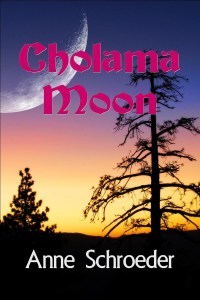 Cholama Moon is available in hard copy from Oak Tree Press, Amazon and bookstores. The e-book version will follow shortly.
Cholama Moon is available in hard copy from Oak Tree Press, Amazon and bookstores. The e-book version will follow shortly.
Anne can be found at https://www.facebook.com/anneschroederauthor and http://anneschroederauthor.blogspot.com/
Anne has very kindly decided to give away one copy of Cholama Moon to one person leaving a comment.
Homesteaders struggle to establish ranches in Central California in the 1870s, amid earthquakes, drought, banditos, remoteness and human failing. Young Virginia Nugent’s privileged life ends with the death of her mother and her father’s guilt-ridden descent into addiction. She is conflicted in her love of the ranch and her desire to escape until an old cowhand’s loyalty and a Southerner friend of her late mother offer hope that she can change her destiny.


March 31, 2014
The Role of Newspapers in Kansas Territory
I felt an immediate affinity for my guest this month, Linda S. Johnston.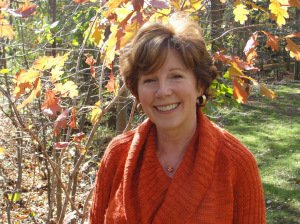 Not only are we the eastern stronghold of Women Writing the West, but we have both lived in Great Britain and have both moved house an inordinate amount of times. While I beat Linda in years spent in the U.K., she certainly outdoes me in moves—more than fifteen, including places as diverse as Margate, England; Seattle, Washington; and Roswell, New Mexico. But it was when she landed in Kansas in 1986 and began reading pioneer diaries that she felt a connection to the emigrants; she knew the emotions of packing up and moving on, leaving familiar places and faces for the unknown. As a writer, artist and naturalist, she combines history, art and nature in her writing as is evident in her first book, Hope Amid Hardship: Pioneer Voices from Kansas Territory.
Not only are we the eastern stronghold of Women Writing the West, but we have both lived in Great Britain and have both moved house an inordinate amount of times. While I beat Linda in years spent in the U.K., she certainly outdoes me in moves—more than fifteen, including places as diverse as Margate, England; Seattle, Washington; and Roswell, New Mexico. But it was when she landed in Kansas in 1986 and began reading pioneer diaries that she felt a connection to the emigrants; she knew the emotions of packing up and moving on, leaving familiar places and faces for the unknown. As a writer, artist and naturalist, she combines history, art and nature in her writing as is evident in her first book, Hope Amid Hardship: Pioneer Voices from Kansas Territory.
After extensive research to bring the personal writings of these settlers to others, and share the happier side of pioneer life, Linda is quite an expert on the role of newspapers in Kansas Territory. I’m delighted for her to be here to share her thoughts with you. *********************************************************************** “The Press, Watson, is a most valuable institution, if you only know how to use it.” –Arthur Conan Doyle, The Adventures of the Six Napoleons/ The Adventure of the Crooked Man
Indeed, people did know how to use the press in regards to Kansas Territory. Perhaps not exactly the way Arthur Conan Doyle meant, but between 1855 and 1860 over 98,000 people settled in Kansas Territory and in some way, newspapers touched them all.
Newspapers served a number of roles in the new territory, carved out of the Louisiana Purchase by the 1854 Kansas-Nebraska Act. For the prospective pioneer, eastern newspapers offered various types of information on the frontier – travel advice, encouragement (“The man who comes here self-reliant will do well”), and news that consisted mainly of debate on the slavery issue. When Kansas Territory was established, it was left to the citizens to decide whether the future state would enter the union as a slave state or free state. Newspapers of both persuasions were up and running early in Leavenworth, Lawrence, and Topeka, the first towns to be settled. Once the emigrants had arrived in their adopted communities, local newspapers provided national and world news as well as information on entertainment, business, and agriculture. Feature articles covered holidays, social events, and the virtues of women. And lest readers become discouraged with their new life, papers such as the Herald of Freedom and Kansas Tribune, offered words of hope.
Eastern cities kept up with events in Kansas through reporters, families of settlers, and subscribers who traveled west, becoming pioneer correspondents.
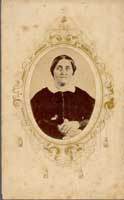
Julia Lovejoy, courtesy of Kansas Historical Society
Julia Louisa Lovejoy settled in Kansas in 1855 with her husband and children. Two weeks after arriving, despite being heartbroken after the death of her young daughter, Julia began reporting to her “New England friends” on the pages of her hometown Concord, New Hampshire, Independent Democrat.
Mouth of the Big Blue River, K.
May 22d, 1855
We arrived at our intended home about two weeks ago, and, notwithstanding the Vacant spot in the home circle, and our own desolate hearts, we must pronounce this the most charming country our eyes ever beheld. . . It seems to us impossible that any spot on earth, uncultivated by art, can be more inviting in appearance than this country.
Editors kept the spotlight on Kansas with not only political news, but also geographic, demographic, and economic coverage. On December 25, 1858, Frank Leslie’s Illustrated Newspaper devoted its front page to the “Cities of Kansas” featuring Lawrence, Leavenworth, and Topeka. Horace Greeley, influential editor of the New York Tribune ran stories from young reporter, James Redpath, who went west in 1856 and reported on the volatile atmosphere in the Territory, keeping Northern readers informed of the struggles between slavery and anti-slavery factions.
New Kansans kept up with elections, conventions, and territorial constitutions by reading the latest edition of their local paper. The presses themselves made news

courtesy of Kansas Historical Society
when the offices of the Herald of Freedom and the Kansas Free State were looted and equipment destroyed during the sack of Lawrence in May 1856.
Kansas newspapers brought national and world news to their readers, often juxtaposed with feature articles. In 1855, the Lawrence Herald of Freedom reported on the annexation of the Sandwich Islands to the United States as well as the fall of Sevastopol during the Crimean War. In May 1857, the article “Ocean Telegraph” provided an update on the laying of wire in the Atlantic. Just below that article, a piece entirely devoted to “Female Delicacy” touted the many features of the female character but pointed out that “delicacy stands foremost within the province of good taste.” In addition, newspapers often provided helpful hints, such as how to preserve flowers and the many uses of cotton cloth, one being as roofing material.
In the growing, and sometimes struggling, new communities of Kansas, newspapers offered encouragement to new citizens, sometimes in the form of poetry. “Try Again” appeared in the June 9, 1855 edition of the Lawrence Herald of Freedom:
How oft has disappointment marred
Some cherished plan of mine,
And bid winter clouds appear
Where summer’s sun should shine;
Yet as they darker grew,
I’ve seen some wondrous pen
Upon the very blackest write
The sentence, “Try again.”
Many early settlers in Kansas went for just that reason – to try again. Eager to establish a better life for their families, trades people of all kinds arrived. Advertisements for new businesses, including ones for an ice cream store and a bookbinder, filled columns in local papers. There seemed to be an ad for each segment of the growing population, including those feeling under the weather: “To Invalids: Cornstarch, tapioca, arrow root, and rice for sale.” For those in need of feathers, they were available “by the pound for feather bolsters and pillows.” And to farmers, interested in setting up housekeeping, this ad: “To Farmers: Corn shucks and oat straw wanted in exchange for furniture.”
Also for farmers, newspapers offered information on crops. “How to” articles appeared on planting Osage Orange trees as hedges and sowing turnip seed. Pumpkins, buckwheat, and sorghum made headlines as bumper crops were harvested. For farmers and shopkeeper alike, social activities meant time to visit with friends and neighbors. From the arrival of Mabie’s Circus to the meeting of the Lawrence Sewing Circle, community gatherings were important events and reported accordingly.
Lastly, newspapers provided a link between family and friends – a way to exchange information from hometown to prairie and back again. For a homesick son or daughter, a hometown paper was a welcome and cherished gift to be read over and over. For a parent or friend in the East, news from the Territory kept them informed about the place their loved one had chosen to begin a new life.
Linda has very kindly offered to give one print copy of Hope Amid Hardship: Pioneer Voices from Kansas Territory to one person leaving a comment. The lucky individual will be announced on or about 23rd April.
Despite the challenges of loneliness, drought, and political turmoil Kansas 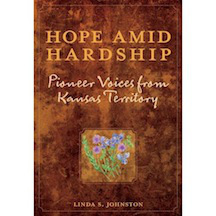 pioneers faced, many found and wrote about joy and beauty in their adopted communities. Letters and diaries describe the times that gave them reason to sing, dance, and celebrate – moments when their burdens were lighter. This beautifully illustrated volume brings together reflections of sixty individuals of different ages, backgrounds, and outlooks who helped shape the identity of the Sunflower State.
pioneers faced, many found and wrote about joy and beauty in their adopted communities. Letters and diaries describe the times that gave them reason to sing, dance, and celebrate – moments when their burdens were lighter. This beautifully illustrated volume brings together reflections of sixty individuals of different ages, backgrounds, and outlooks who helped shape the identity of the Sunflower State.
Linda Johnston can be found at www.lindasjohnston.com and https://www.facebook.com/pages/Linda-S-Johnston-Author/123981281119230
Hope Amid Hardship can be purchased at http://www.amazon.com/Hope-Amid-Hards...


March 19, 2014
Springtime in the Rockies & the Oysters are Here!
Welcome to the Springtime in the Country Blog Hop! I’ll be giving away one digital copy of Loveland to someone who leaves a comment below. All visitors who leave a comment and/or tweet about the Hop will be in the running for a $100 Amazon gift card. Please click the button and go to the rafflecopter to join the fun! And for the full list of authors participating, go to http://cowboycharm.blogspot.com/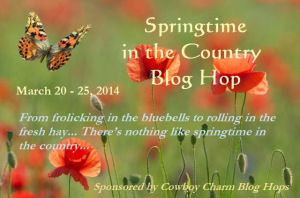
Springtime in the Rockies and a cowboy thinks of…oysters??? Yup, it’s time for branding and, well, turning bull calves into steers. And that means the oysters are here! That lovely delicacy can be served several ways, but Amber Scholl of the Cottonwood Ranch has given me this delicious recipe. If you can obtain the main ingredient I guarantee that with a bit of hot sauce it will definitely turn your cowboy’s thoughts to that other item for spring–love! After all, the way to a man’s heart…
Here’s Amber’s recipe:
First you take the testicle and make a long incision vertically, just to remove the first membrane. Cut all remaining parts until membrane is completely separate. Wash or soak for an hour in cold water. Next, you want to get your batter ready which includes approx. 1cup of flour, 2tbs of garlic powder (the more the better), 1tbs salt, 1tbs pepper, 1tbs seasoning salt (optional). Once your batter is ready, get your 1 cup of peanut, vegetable, or canola oil hot in your frying pan. I prefer cast iron pans over anything, and peanut oil. While your oil is heating you want to then remove the second membrane from the “oyster”. To do this, you make another incision in the membrane until you can squeeze the meat out. It will naturally separate and then goes directly into the flour mixture. Once fully coated, add to oil, and cook until brown and crisp, maybe 8 minutes or so. Serve with fry sauce, ketchup, or anything else you prefer.
There are many ways to cook these, this is my favorite.


March 3, 2014
They Don’t Drive Pickups in New York
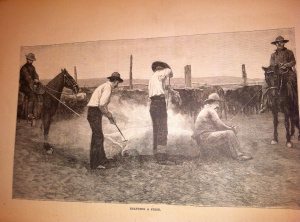 I was leafing through Frank Leslie’s Popular Monthly of April, 1892, in the hope of finding some material with which to greet the (hopefully) coming spring when I happened upon a romantic story entitled, ‘The Owner of LT Ranch.’ Since anything to do with ranching and cowboys is always of interest to me, I naturally had a quick read. What struck me immediately was the different ways in which the ranch owner, an easterner from New York, and the local characters were portrayed. To sum it up as best I can, a local rancher’s wife is depicted as introducing the heroine of the tale with the words, “un o’ our neighbors ‘cross the crick,” (sic) while the heroine refers to the hero as, “A real live New York gentleman out on the plains of Kansas—and he don’t know what a fence cutter is…”
I was leafing through Frank Leslie’s Popular Monthly of April, 1892, in the hope of finding some material with which to greet the (hopefully) coming spring when I happened upon a romantic story entitled, ‘The Owner of LT Ranch.’ Since anything to do with ranching and cowboys is always of interest to me, I naturally had a quick read. What struck me immediately was the different ways in which the ranch owner, an easterner from New York, and the local characters were portrayed. To sum it up as best I can, a local rancher’s wife is depicted as introducing the heroine of the tale with the words, “un o’ our neighbors ‘cross the crick,” (sic) while the heroine refers to the hero as, “A real live New York gentleman out on the plains of Kansas—and he don’t know what a fence cutter is…”
Well, times have changed and the world is a smaller place thanks to television, Internet and the rest of the digital- and tele-communications upon which we so heavily rely nowadays. Local accents are smoothing out somewhat and airfreight makes the same foods available in Washington DC as in Washington state. While the average New Yorker may not have use for a fence cutter, he will most certainly know what they are.
Yet differences exist—they have to. We live in different geographies and different climates. Our histories are different as are our economies. Indigenous peoples created backgrounds to which lines of immigrants and settlors brought different cultures. As immigration continues to occur, it will continue to impact local populations. And differences exist within the west and within the east for the very same reasons. Boston is different from NYC, Denver is a contrast to Santa Fe and California is a law unto itself. In many ways, the southeast bears more resemblance to the west than it does to the north. So, in BROAD, GENERAL TERMS, what differences do I note when I, as that ‘real live’ New Yorker, find when, several times a year, I head west? With my tongue in the general vicinity of my cheek, here’s what I note:
In New York:
We don’t drive pickups. (Anything in the back would be stolen within seconds when parked);
Y’all is not a word;
Groceries are delivered to your door;
Dogs are generally small and have to be walked on a leash, and the owner has to collect the dog’s mess;
Gun clubs are predominantly cops and folks wanting to rob the local 7/11;
Two stepping is unknown, Texas two stepping totally unheard of;
Kenny Chesney is basically known as a former husband of Renee Zellwegger—few actually listen to his music;
A sprinkler system is to water the plants at your country retreat, not to water the foundation of your home in hot weather as in TX;
Not a cowboy hat/Stetson in sight except when the PBR comes to Madison Square Garden in January;
Jeans are rarely Levi’s or Wranglers;
Grass fed beef is something exotic on a menu not the cows out your window;
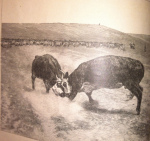
If you happen to keep a horse or at least ride, you ride English and wear English gear;
Horses are kept in a stable not a barn;
You don’t have a garbage disposal unit in your kitchen;
You cannot write about your ancestors horrific journey across the Great Plains as they headed west because the west was NYC to them;
You have no interesting outlaws in your ancestry nor do your forebears and relations include any Tys, Coles, Cals, Jesses, et.al;
Jack is the fellow your daughter is dating, not something in a glass;
A man who’s been rebuilt is a cartoon superhero, not a Professional
 Bull Rider who’s had multiple accidents;
Bull Rider who’s had multiple accidents;‘Cowboy Poetry’ consists of Roy Rogers singing “Happy Trails”;
A plaid shirt with snaps is something worn to bed not out on the range;
A range is something you cook on;
Rocky Mountain Oysters are a strange ingredient on cooking shows which most people think are actual oysters;
We can live without a car though many don’t;
’Wide open spaces’ in NYC is Central Pk. measuring 1.317 sq. miles;
Cold in NYC is 30°, cold in the NW is -5°; very cold in NYC is 18°, very cold in the NW is -27°;
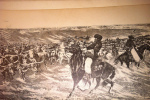
And finally: A cowboy is someone who is meant to repair something in your home, does a lousy job and overcharges NOT someone who rides a horse and looks after cattle
And is the hero of the west…
Please add to this list below. I will try not to take offense 
***********************************************************************
AS part of the Fool for Romance blog hop, I am happy to be giving away one digital copy of my western historical romance, Loveland, to someone who likes my Facebook page at https://www.facebook.com/writerAndrea... if you haven’t already and then answers the question: What is the setting for my story, Lawless Love? The answer should be sent via the comment box on this website at http://andreadowning.com/about/ and the answer can also be found on this website. The Fool for Romance blog hop runs all month.


March 1, 2014
What is Sharing and why do you need to encourage it?
I’m pleased to have literary promotion experts Babs Hightower and Barb Drozdowich with me today to give a little insight into the world of social media.

Babs Hightower
Babs has been helping authors since 2000 with her book review blog, Babs Book Bistro. As well as the beginning of helping authors promote themselves, it proved to be her start in PR. In 2012, she commenced working for Entangled Publishing and is now Publicity Director for the Scandalous Imprint. She is also publicist for World Castle Publishing. When not helping others, she writes historical romance under the pen name of Morgan Kincaid. She has published 2 books to help authors understand more of what goes on in publishing and Goodreads.
Social media and WordPress Consultant Barb Drozdowich has taught at colleges

Barb Drozdowich
and universities, trained technical personnel in the banking industry and, most recently, used her expertise to help dozens of authors develop the social media platform needed to succeed in today’s fast evolving publishing world. She owns Bakerview Consulting and manages the popular Romance Book blog, Sugarbeat’s Books. Barb has published 4 books specifically to help authors understand some of the technical issues that they come across when promoting their books.
I’m happy to have them share some of their knowledge with you.
***********************************************************************
Authors love to get comments on their blog posts – don’t we all? Comments are lovely! We often see comments encouraged in blog tours that are posted on our blog as well as others. In the big scheme of things, however, comments are not very important. Sharing is hugely important. Sharing buttons are those little icons that sit at the top or bottom of post or maybe float along the side. Ideally, they have icons for every social media platform known to man.
It’s your job to create great content that your readers want to share with their friends and followers. We don’t care if you don’t have a Stumbleupon account. Maybe your readers do and that’s where they want to share. You just need to make the content interesting and easy to share. You want your readers to share your post on Twitter, on Facebook, on Stumbleupon and on whatever other social media accounts they favor.
Easy, right?
So why do we think that sharing is more important than comments? Because Google thinks that sharing is more important than comments. Although readers will find your blog from many sources, some will find you from a Google search. You want to do everything that you can to make your blog rank as high as possible in a Google search. Think about it – most people will only look through the first few pages of a Google search. So, you want to be on one of those first few pages.
Understanding some of the technical aspects to promoting your books is challenging for many authors. Authors write beautiful stories – that’s what they do really well! You wouldn’t hesitate to take a writing course or go to a workshop. Likewise, don’t waste your valuable writing time wrestling with technical issues; ask for help.
***********************************************************************
Babs and Barb have kindly decided to give away copies of any one of their several books to two lucky people leaving a comment or question. Winners will be announced evening of March 3rd.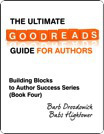

Babs can be found:
Babs Book Bistro website: http://www.babsbookbistro.net
Babs Hightower PR website: http://www.babshightowerpr.com
Author website: http://morgankincaid.com
Twitter: https://twitter.com/babsbookbistro
Twitter: https://twitter.com/BabsMorganKin
Facebook: https://www.facebook.com/BabsHightowerPr
Facebook Author: https://www.facebook.com/authormorgankincaid
LinkedIn: http://www.linkedin.com/in/babsbookbistro/
Goodreads: http://www.goodreads.com/user/show/1970552-babs
Google +: https://plus.google.com/u/0/102563748897854093407/posts
Pinterest: http://www.pinterest.com/babsbookbistro
Barb can be found:
Bakerview Consulting (Business Site) http://bakerviewconsulting.com
Barb Drozdowich (Author Site) http://barbdrozdowich.com
Sugarbeat’s Books (Book Blog) http://sugarbeatsbooks.com
Facebook(Author blog) https://www.facebook.com/BarbDrozdowichAuthor
Twitter http://twitter.com/sugarbeatbc
Google+ https://plus.google.com/110824499539694941768


January 30, 2014
KIT CARSON: ‘GREAT AMERICAN HERO’ or ‘VILLAIN OF NAVAJO HISTORY’?
I met Steven Kohlhagen through the American Westerns group of Goodreads. Steve kindly complimented me on the article I had written regarding posterity and memoirs, one of which was Buffalo Bill Cody’s Story of the West. Steve’s latest book, Where They Bury You,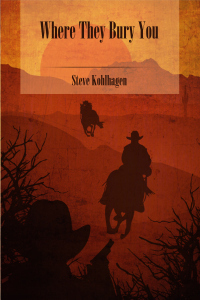 partially concerns Kit Carson, and Carson was one of the men Cody had memorialized. Carson’s scorched earth policy, used to remove the Navajo from their homeland, is something that, today, denigrates the man’s other accomplishments as a frontiersman. Yet, Cody claimed that the policy had actually saved lives. I therefore approached Steve to find out what his own research had uncovered.
partially concerns Kit Carson, and Carson was one of the men Cody had memorialized. Carson’s scorched earth policy, used to remove the Navajo from their homeland, is something that, today, denigrates the man’s other accomplishments as a frontiersman. Yet, Cody claimed that the policy had actually saved lives. I therefore approached Steve to find out what his own research had uncovered.
Kohlhagen is a former economics professor at the University of California, Berkeley, a former Wall Street investment banker, and is on several corporate boards, most notably that of Freddie Mac. He is the author of numerous economics publications as well as co-author of a murder mystery, Tiger Found, with his wife, Gale.
The Kohlhagens divide their time between homes in the San Juan Mountains on the New Mexico-Colorado border and Charleston, South Carolina.
Flash back 151 years to February 1863.
At that time Kit Carson was a bona fide American hero. It’s right there in Herman Melville’s Moby Dick: frontiersman, mountain man, Indian fighter. He was also a hero of the Mexican-American War, “Father Kit” to the Ute and Apache Indians on his Agency, fictional hero-savior to any number of innocent women and children in distress in the 19th Century “Blood and Thunder” dime novels, and loving Taos father and husband to, over time, two Indian wives.
On the other hand, the Navajo Indians—the Dine—were friendless throughoutthe West. Ill-treated by the Spaniards in the preceding centuries, the Navajos discriminated against no one in robbing, pillaging, murdering, and enslaving women and children. The Dine succeeded in the seemingly impossible: uniting Whites, New Mexicans, Pueblo Indians, Cheyenne, Utes, Mexicans, and all manner of Apache tribes in their hatred and fear of marauding Navajo warriors. Even the Navajo headsmen, when confronted with the opportunity to bring peace, admitted that it was beyond their power to stop their young men from raiding. They essentially responded to attempts by the U.S. Army to enlist their support with the 19th Century equivalent of “Kids today!”
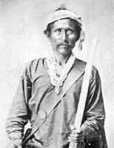
Barboncito, Navajo Chief
What about 2014? The general view of the Navajo today is one of a venerable, peaceful Native American culture. A spiritual nation inhabiting their Reservation on their native lands in northern Arizona. A people that, to this day, largely view Kit Carson as a genocidal murderer of innocent Navajo.
And, if asked to name great American frontiersman, very few Americans get to Kit Carson’s name.
What happened during the intervening 150 years to bring about this 180-degree switch?
My first introduction to the legend of Kit Carson was by a young Navajo guide on a private tour of Canyon de Chelly. He took me to a medium-high, cylindrical hill covered with brush and small trees deep in the canyon and said, “That’s where Kit Carson brought the Navajo women, children, and elderly and massacred them.” Years later, a friend told me of his tour of the Canyon and the story he’d been told of the massacre there by the Spaniards centuries before Kit Carson. And then I read Hampton Sides wonderful Blood and Thunder. That book launched me into research into the history of the Southwest. A passage in it inspired me to write my own novel, Where They Bury You, a murder mystery based on the actual 1863 murder of Joseph Cummings, U.S. Marshal of Santa Fe and Army Major reporting to Carson.
Six or seven generations of Navajo oral history about the horrible 1860’s “Long Walk” to Bosque Redondo has left many, if not the majority, of living Navajo believing that Carson was responsible.

General Carleton
The truth is that Bosque Redondo was the misguided vision and policy of one General James Henry Carleton, head of the Union Army in the Territories. When the Civil War battles ended in the New Mexico and Arizona Territories in 1862, the Navajo and Mescalero Apaches continued raiding and killing, and in the case of the Navajo, enslaving the local New Mexican people. Carleton decided the only answer was to round them up and deport them to Bosque Redondo, a totally inappropriate section of land along the Pecos River in eastern New Mexico.
Carson objected to the policy as untenable and tried to retire to his family and his Ute and Jicarilla Apache Agency. But Carleton insisted that the famous frontiersman carry out this last patriotic duty.
First, Carson induced the Mescalero to surrender and delivered them to Bosque Redondo.
The Navajo turned out to be a bigger challenge. They simply vanished into the deserts and canyons of their homeland. Carson, frustrated by his inability to find the Navajo and their previous refusals to stop raiding and killing the other neighboring tribes and New Mexicans, implemented a scorched earth policy throughout the Dine homeland. It took nine months, but the Navajo people began trickling in and surrendering. Some deaths obviously may have occurred due to the conditions in which the Navajo were then forced to try to survive, but there was never any massacre per se. In fact, Carson, objecting to the 9,000 person four hundred mile walk without adequate support, returned home to Taos for several months. He then insisted on being the Indian Agent at Bosque Redondo in a failed attempt to help the Navajo adjust to their new home.
Bosque Redondo was a colossal failure. The Mescalero just up and left one night in 1865 to return to what continues to be their home near Ruidoso, New Mexico. The Navajo negotiated their departure and walked the four hundred miles back home in June 1868, one month after the 55 year old Carson died in Taos.
At the time, General Carleton was blamed for the failure and returned to his Texas home to die in relative obscurity in 1878. The Navajo, though, have never stopped blaming Carson for their hardships and deaths. Today, the Navajo story and memory of Carson’s culpability resonates better in the public American culture, while the numerous Navajo depredations and Carleton’s miserable failure have long faded into history. In contrast to modern New Mexicans, some modern Native American tribes still do retain a cultural memory of the negative Navajo history.
Justifiable or not, reaction to the Navajo oral tradition had caused Carson to lose his chance to be remembered alongside Davy Crockett and Buffalo Bill Cody and Lewis and Clark as a first string All-American legend.
How he actually felt about the Indians is best expressed by Carson himself.
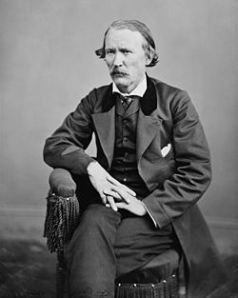
Kit Carson
When the truly despicable Methodist Minister and commander of the Colorado Volunteers, John Chivington, massacred the elderly, the women, and children at the Cheyenne village at Sand Creek in 1864 while their warriors were out hunting, Carson was asked to testify at the resulting Congressional inquiry. He testified:
“Jis to think of that dog Chivington and his dirty hounds, up thar at Sand Creek. His men shot down squaws, and blew the brains out of little innocent children. You call sich soldiers Christians, do ye? And Indians savages? What der yer ‘spose our Heavenly Father, who made both them and us, thinks of these things?
“I tell you what, I don’t like a hostile red skin any more than you do. And when they are hostile, I’ve fought ‘em, hard as any man. But I never yet drew a bead on a squaw or papoose, and I despise the man who would.”
***********************************************************************
Steve was inspired to write his latest novel after reading Hampton Sides‘ wonderful Blood and Thunder. This non-fiction history of Kit Carson and the West includes a report of the factual murder of Marshall Joseph Cummings on August 18, 1863, and led Kohlhagen to conduct further research, including work at the National Archives. He found Carson’s explanation for Marshal Cummings’ murder to be implausible. The result is his historical murder mystery, Where They Bury You.
Steve has very kindly offered to give away one autographed copy of Where They Bury You to someone leaving a comment. The winner will be announced on or about 22 February. The book can also be purchased at http://www.amazon.com/Where-They-Bury-You-Novel/dp/0865349398/ref=tmm_hrd_swatch_0?_encoding=UTF8&sr=1-1&qid=1389914377
Steve can be found at:
http://www.amazon.com/Steven-W.-Kohlhagen/e/B00E5LZ0B4/ref=ntt_dp_epwbk_0
https://www.facebook.com/SteveKohlhagenAuthor
https://www.facebook.com/stevenw.kohlhagen


January 2, 2014
A Call to Glory: The Last US Cavalry Campaign
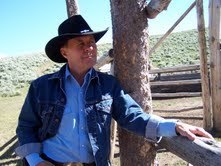
Paul Colt
I’m pleased to have Paul Colt return to this site this month. Paul, who hopefully needs no introduction by now, has a new book out. Boots and Saddles: A Call to Glory has had a splendid review in Publisher’s Weekly: “Colt’s novel is hyped as a story about George Patton’s early career as a cavalry officer in the U.S. Army, but really is much more. The Patton angle is certainly interesting, but it’s Colt’s sweeping and historically vivid portrayal of the punitive expedition, American and Mexican relations, and German double-dealing that really makes this novel an exciting and stunning success.” Let’s hear more:
PAUL COLT:
I’ve observed in these pages in the past once in a while historical research can uncover a little known circumstance or event lost in our conscious recollection. I call it “unexpected history.” It may be an oxymoron but I love that premise for a book. You know the synopsis conversation you have at a cocktail party that elicits the response: ‘I had no idea.’ One of those discoveries gave rise to the book I call Boots and Saddles: A Call to Glory.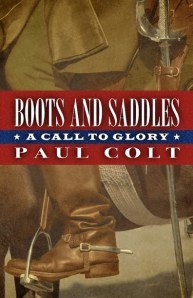
I stumbled on it reading Jeff Shaara’s book on the Normandy invasion, Steel Wave. In his book, Shaara made a background reference to Patton having served under John J. Pershing in his pursuit of Pancho Villa. I remembered reading something about Pershing and Villa, but I was surprised to learn Patton played a part in it. We have this iconic image of Patton as famously portrayed by George C. Scott. The Shaara line suggested a young George Patton, unknown before he became that icon. You had Patton, Pershing and Villa, three compelling characters, together in a dusty corner of history. I had to take a deeper dive.
What I discovered was a fascinating story—two stories really. The first is the turning point that saved young Patton’s military career. We very nearly lost one of our most consequential World War II military leaders to the frustrations of a mid-career crisis. The second story is nothing less than the end of an era, the last United States Cavalry campaign. What a wonderful combination. It’s a story that had to be told.
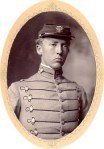 In 1913, George Patton is a thirty year old cavalry officer. He is a West Point graduate and the Army’s first Saber Master. He is a nineteenth century warrior, facing the emerging realities of twentieth century warfare. He has served long past his junior officer time in grade, and remains the lowly Second Lieutenant he was commissioned out of the academy. A man of action, he is shuffled from one staff job to another with no line assignment to give chance for promotion. His vision of a glorious military career is fading with each passing year.
In 1913, George Patton is a thirty year old cavalry officer. He is a West Point graduate and the Army’s first Saber Master. He is a nineteenth century warrior, facing the emerging realities of twentieth century warfare. He has served long past his junior officer time in grade, and remains the lowly Second Lieutenant he was commissioned out of the academy. A man of action, he is shuffled from one staff job to another with no line assignment to give chance for promotion. His vision of a glorious military career is fading with each passing year.
Patton married his adolescent sweetheart. Beatrice Ayer Patton is the love of his life, yet the life he gives her as a junior officer’s wife is a hard one. They move from one remote post to the next, subsisting on low wages and bare essential living conditions. A girl accustomed to privilege, ‘Beat’ bears all of it with little complaint, yet she sees her husband’s growing frustration and wonders where all of this leads.
The outbreak of war in Europe deepens Patton’s frustration. President Woodrow Wilson proclaims America neutral. The president stands passively by in the face of German aggression. Patton receives something of a reprieve when he is assigned to the Eighth Cavalry at Fort Bliss, El Paso, Texas. The Eighth is one of five cavalry regiments, under the command of Brigadier General John J. Pershing, deployed to secure the Mexican border against the threat of 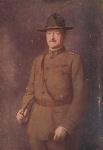 revolutionary hostilities crossing into the U.S.
revolutionary hostilities crossing into the U.S.
El Paso is another dusty disappointment for Beatrice. The dreary reality of military life is punctuated by long periods of separation that weigh on the young couple. Increasingly, reason leads to the conclusion that the glorious career George envisions is slipping away. The only prudent course would be to resign his commission in favor of some civilian pursuit.
In March 1916, Pancho Villa raids Columbus, New Mexico. President Wilson orders a Punitive Expedition to bring the revolutionary bandit to justice. Pershing is given command. He prepares to lead the Seventh, Tenth, Eleventh and Thirteenth cavalry regiments into Mexico on what will become the last United States Cavalry campaign. Patton and the Eighth will stand rear guard. Patton refuses to be left behind. He boldly argues his way onto Pershing’s staff.
Pershing mounts an aggressive campaign to apprehend Villa under difficult mountainous conditions. Patton confronts twentieth century warfare first hand. Reconnaissance and communications, traditional cavalry missions, are usurped by the Army’s fledgling air service and the marvel promise of wireless communications. Modern ballistics render the cavalry obsolete as a fighting force. Mexican federal forces repeatedly crush Villa’s signature cavalry charge. Patton’s beloved saber is useless against such firepower. He views these developments with a wary eye that sees no place for his training in this twentieth century military.
Pershing recognizes the young man’s frustration. He knows the army is ill-prepared for the coming conflict in Europe. It will need officers of young Patton’s stripe. The General extends a mentor’s hand to encourage the young officer. He assures Patton that “Time and invention” will lead him to new purpose.
On a routine supply mission, Patton sees an opportunity to search a suspected Villa hideout. He turns his supply operation into a mechanized assault that flushes out elements of Villa’s elite Dorado guard. In the firefight that follows, he has the opportunity to test himself in combat. He is pleased by the result and takes comfort in knowing he has the metal for field command.
Villa and battlefield success elude Pershing’s forces. Politics reduce the Punitive Expedition to the blunt instrument of a clumsy diplomacy. The last United States cavalry campaign fails to achieve its objective. As the storied American horse soldier passes into the pages of history, the United States prepares to enter the war in Europe. Pershing is given command of the American Expeditionary Force. He takes, now Captain, Patton with him. A new cavalry is born out of that conflict. A warrior emerges who will lead an armored cavalry to glory in the two great wars that follow.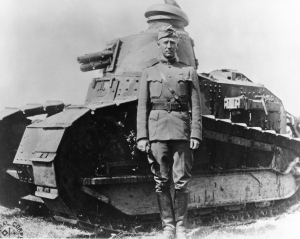
And so we find Patton, Pershing and Villa together in a dusty corner of history. Who knew? Most don’t. Some may suggest the story isn’t a western. It most certainly is. It takes place in the west. Every other western cavalry campaign qualified, certainly the last must. Oh, and that shootout with the Dorado guards, Wyatt Earp would have approved of young Patton, blazing away with his signature single action Colt revolver. There’s a story behind that too. You can find it in Boots and Saddles: A Call to Glory, brought to you by Five Star Publishing. It’s available at fine booksellers everywhere. How’s that for shameless self-promotion?
Thanks, Andi.
Paul Colt
***********************************************************************
Paul has very kindly offered to give away one hardcover copy of Boots and Saddles: A Call to Glory to one person, randomly chosen, who leaves a comment. Winner will be announced on or about the 23rd Jan. For further info on this and Paul’s other books, please go to http://www.paulcolt.com
November 30, 2013
Until Our Paths Meet Again–Native American Wisdom
When I was beginning to think of what I might post for my December blog, the month of Christmas and Chanukah, I happened upon an old post on the website of fellow Wild Rose Press author, Beth Trissel. It struck me immediately—old American Indian sayings that were far more spiritual than any Christmas card I’ve ever received. I asked Beth if she would consent to reposting this piece here on my website and, happily, she consented.
Beth lives with her husband on a farm in the Shenandoah Valley of Virginia, surrounded by children, grandchildren, and many animals. She is the author of The Native American Warrior series: Red Bird’s Song, Through the Fire, The Bearwalker’s Daughter, Kira, Daughter of the Moon, a short story The Lady and the Warrior. and colonial American Christmas romance novella A Warrior for Christmas. She also writes paranormal romance as well as nonfiction about gardening, herbal lore, and country life.
Thanks for inviting me to repost my Native American sayings on your lovely blog, Andrea. I’ve collected these quotes over the years and am a huge fan of American Indians, with a particular interest in Eastern woodland tribes, especially the Shawnee. My early American ancestors had interactions with this tribe. Some were killed and taken captive during the French and Indian war and other conflicts. The events recorded in old annals inspired the first novel I ever wrote, award-winning historical romance novel, Red Bird’s Song. The outstanding hero in that story, Wicomechee, is based on an actual Shawnee warrior to whom I have family ties. There’s more on the real Wicomechee at the end of the novel as a perk for readers. The events behind many of my novels are based on research and family genealogy. Now, back to the quotes. I hope your readers appreciate them:
“Treat the earth well: it was not given to you by your parents, it was loaned to you by your children. We do not inherit the Earth from our Ancestors; we borrow it from our Children.” ~ Ancient Indian Proverb
“Certain things catch your eye, but pursue only those that capture your heart.” ~Old Indian saying
“When you were born, you cried and the world rejoiced. Live your life so that when you die, the world cries and you rejoice.” ~ Cherokee Expression
“Humankind has not woven the web of life. We are but one thread within it. Whatever we do to the web, we do to ourselves. All things are bound together. All things connect. We are a part of the earth and it is part of us.” ~Chief Seattle, Duwamish
“Lose your temper and you lose a friend; lie and you lose yourself.” ~Hopi
Only after the last tree has been cut down, only after the last river has been poisoned, only after the last fish has been caught, only then will you find money cannot be eaten.–Cree Prophecy
“May the warm winds of heaven blow softly upon your house. May the Great Spirit bless all who enter there. May your moccasins make happy tracks in many snows, and may the rainbow always touch your shoulder.” ~ Cherokee Prayer Blessing
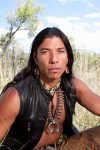 “Wakan Tanka, Great Mystery, teach me how to trust my heart, my mind, my intuition, my inner knowing, the senses of my body, the blessings of my spirit. Teach me to trust these things so that I may enter my Sacred Space and love beyond my fear, and thus Walk in Balance with the passing of each glorious Sun.” ~ Lakota Prayer
“Wakan Tanka, Great Mystery, teach me how to trust my heart, my mind, my intuition, my inner knowing, the senses of my body, the blessings of my spirit. Teach me to trust these things so that I may enter my Sacred Space and love beyond my fear, and thus Walk in Balance with the passing of each glorious Sun.” ~ Lakota Prayer
“Honor the sacred. Honor the Earth, our Mother. Honor the Elders.
Honor all with whom we share the Earth:-
Four-leggeds, two-leggeds, winged ones,
Swimmers, crawlers, plant and rock people.
Walk in balance and beauty.” ~Native American Elder
“O’ Great Spirit, help me always to speak the truth quietly, to listen with an open mind when others speak, and to remember the peace that may be found in silence.” ~ Cherokee Prayer
“We must protect the forests for our children, grandchildren and children yet to be born. We must protect the forests for those who can’t speak for themselves such as the birds, animals, fish and trees.” ~ Qwatsinas, Nuxalk Nation
“What is life? It is the flash of a firefly in the night. It is the breath of a buffalo in the wintertime. It is the little shadow which runs across the grass and loses itself in the sunset.” ~ Crowfoot, Blackfoot warrior and orator
“…Everything on the earth has a purpose, every disease an herb to cure it, and every person a mission. This is the Indian theory of existence.” ~ Mourning Dove, Salish
“The Great Spirit is in all things, he is in the air we breathe. The Great Spirit is our Father, but the Earth is our Mother. She nourishes us, that which we put into the ground she returns to us….” ~Big Thunder (Bedagi) Wabanaki Algonquin
“One does not sell the land people walk on.” ~Crazy Horse, Oglala Sioux, Sept. 23, 1875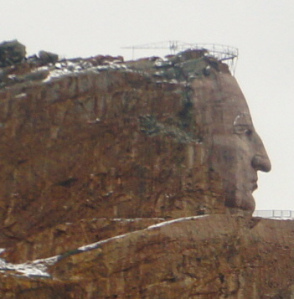
“Where today are the Pequot? Where are the Narragansett, the Mohican, the Pokanoket, and many other once powerful tribes of our people? They have vanished before the avarice and the oppression of the White Man, as snow before a summer sun. Will we let ourselves be destroyed in our turn without a struggle, give up our homes, our country bequeathed to us by the Great Spirit, the graves of our dead and everything that is dear and sacred to us? I know you will cry with me, ‘Never! Never!’” ~The Great Chief Tecumseh~ Shawnee (My absolute favorite chief)
“When it comes time to die, be not like those whose hearts are filled with the fear of death, so when their time comes they weep and pray for a little more time to live their lives over again in a different way. Sing your death song, and die like a hero going home.” ~Chief Aupumut, Mohican. 1725
“From Wakan-Tanka, the Great Mystery, comes all power. It is from Wakan-Tanka that the holy man has wisdom and the power to heal and make holy charms. Man knows that all healing plants are given by Wakan-Tanka; therefore they are holy. So too is the buffalo holy, because it is the gift of Wakan-Tanka.” – Flat-Iron (Maza Blaska) Oglala Sioux Chief
“When the Earth is sick, the animals will begin to disappear, when that happens, The Warriors of the Rainbow will come to save them.” ~ Chief Seattle, Duwamish
“I am a red man. If the Great Spirit had desired me to be a white man he would have made me so in the first place. He put in your heart certain wishes and plans, in my heart he put other and different desires. Each man is good in his sight. It is not necessary for Eagles to be Crows. We are poor…but we are free. No white man controls our footsteps. If we must die…we die defending our rights.” ~ Sitting Bull, Hunkpapa–Head of the Circle–Lakota Sioux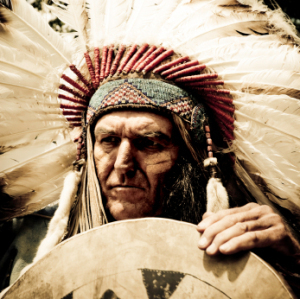
“I will follow the white man’s trail. I will make him my friend, but I will not bend my back to his burdens. I will be cunning as a coyote. I will ask him to help me understand his ways, then I will prepare the way for my children, and their children. The Great Spirit has shown me – a day will come when they will outrun the white man in his own shoes.”~ Many Horses, Oglala Lakota
“If you talk to the animals they will talk with you
and you will know each other. If you do not talk to them
you will not know them, and what you do not know
you will fear. What one fears one destroys.” ~Chief Dan George, author, poet and actor, Tsleil Waututh
***********************************************************************
Beth has very kindly agreed to give away 3 digital copies of Red Bird’s Song, 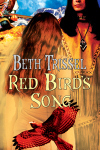 either pdf or kindle, to selected readers leaving a comment. The winners will be announced here on or about the 18th December.
either pdf or kindle, to selected readers leaving a comment. The winners will be announced here on or about the 18th December.
Can a Scots-Irish woman terrified of warriors fall in love with her Shawnee captor?
Taken captive by a Shawnee war party wasn’t how Charity Edmondson hoped to escape an unwanted marriage. Nor did Shawnee warrior Wicomechee expect to find the treasure promised by his grandfather’s vision in the unpredictable red-headed girl.
George III’s English Red-Coats, unprincipled colonial militia, prejudice and jealousy are not the only enemies Charity and Wicomechee will face before they can hope for a peaceful life. The greatest obstacle to happiness is in their own hearts.
As they struggle through bleak mountains and cold weather, facing wild nature and wilder men, Wicomechee and Charity must learn to trust each other.
Amazon Link for Red Bird’s Song
For more on Beth, visit her blog: http://bethtrissel.wordpress.com/ Visit Beth’s Amazon Author Page Catch her on Facebook, Twitter @bethtrissel, Pinterest (http://www.pinterest.com/bctrissel/)
***********************************************************************
Photo of Crazy Horse monument by Cristal Downing; all other photos supplied by Beth Trissel


November 4, 2013
Destiny’s Manifest – What the Pioneers Packed for the Emigrant Trails
 LaDene Morton and I first met at the Women Writing the West Conference in 2012. LaDene, who writes both fiction and non-fiction, served this year as VP Conference for WWW in her home town of Kansas City, MO—a place of particular interest in her writing, which centers on the American West. Her historical fiction, What Lies West, was a 2010 Finalist in the WWW WILLA competition. After reading and thoroughly enjoying the book, I asked LaDene if she would share some of the huge amount of research
LaDene Morton and I first met at the Women Writing the West Conference in 2012. LaDene, who writes both fiction and non-fiction, served this year as VP Conference for WWW in her home town of Kansas City, MO—a place of particular interest in her writing, which centers on the American West. Her historical fiction, What Lies West, was a 2010 Finalist in the WWW WILLA competition. After reading and thoroughly enjoying the book, I asked LaDene if she would share some of the huge amount of research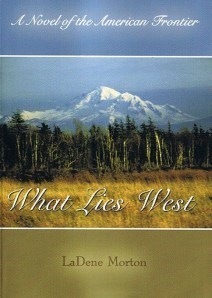 materials she found concerning what it was like to cross that great unknown prairie of the mid-1800s, starting out from Missouri. I’m delighted she agreed.
materials she found concerning what it was like to cross that great unknown prairie of the mid-1800s, starting out from Missouri. I’m delighted she agreed.
LADENE MORTON:
When I was invited to do this guest blog, I had no idea how much I would enjoy revisiting an earlier research project. Andi has asked me to share some of what I’ve learned about the mechanics of preparing to travel the Overland Trails, discovered during research for my 2010 novel, What Lies West. I assume that’s something that clicked in her imagination when she read the book. It certainly did click with me, and I was more than happy to return to those travels – mine as I researched, and my characters’ as they set out west.
The novel begins in 1850 with a young widow seizing an opportunity to travel west with a wagon company. Lina Clark, my protagonist, had a strategic advantage over others she would join on the trip – she had experience as an outfitter – and so she would know better than most what would be needed. Here, some level of detail was required. So Lina – and I – needed a shopping list. Easy enough, for there’s no end of scholarly research and primary sources that provide similar information to form what would be reasonable cargo. Two notable travel guides of the day remain in print, first and most infamously the 1845 Hastings Guide[1] and, later, Captain Marcy’s The Prairie Traveler[2]. 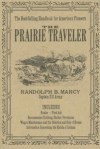 The books included information on what to take, what the general threats and conditions were like (like a good travel brochure, generously accurate), descriptions of the terrain they would cross (also a bit rosy hued), and the routes to take.
The books included information on what to take, what the general threats and conditions were like (like a good travel brochure, generously accurate), descriptions of the terrain they would cross (also a bit rosy hued), and the routes to take.
About those routes – it was the Hastings’ guide that the Donner Party took with them, which led them – among other unwise decisions – to choose the not-coincidentally named Hastings Cutoff. After that, the War Department, eager not to have all its efforts to recruit settlers end in similar tragedy, commissioned Captain Randolph Marcy to write The Prairie Traveler in 1859, which became the preferred guidebook.
The modern reader would certainly find it hard to glean the useful information from these books. Accustomed as we are to graphs, charts and other visual displays of information, these books are densely worded narratives. But it was the written language of the day, after all, and literacy was relatively high back then, particularly in the eastern states where the opportunities for recruitment were rich. Even if they could read it, it’s doubtful many did, or not thoroughly. The spirit of adventure that many sought – particularly the gold rushers and speculators – made over preparation anathema. They had manifest destiny. What more did they need, right?
Actually, they needed less. For the record, here is a summary list of what those books advise bringing:
Per person, about 250 pounds of food stuffs, sixty percent of which was flour. The rest included bacon, coffee, sugar, potatoes, dried fruit, oil and corn. For bedding and such, a pillow and three blankets, a towel and some canvas or oil cloth.
For the household items, a camp kettle, various skillets and pans, and a coffee pot. Utensils, pans and cups of course. A tin bucket – no wood, which would shrink and render the tool useless. An axe, a hatchet and a spade, some chain, two hemp lariats and matches in bottles. An awl and some buckskin for leather repair was greatly advised.
The wagon and its equipment accounted for most of the weight to be carried. The two extra bows and wagon tongues, related hardware and a tar bucket would have also consumed a lot of space, which was at a premium. Each wagon would have carried at least two weapons and plenty of ammunition, too.
Personal items for each traveler would have been grooming and hygiene items at their most basic, simple hand tools like knives and notions, and no more than an extra of the basic clothes items for man or woman. And of course, a hat was a must.
That’s it. That’s all one could take – and even that might not be the right mix, depending on the trials of each wagon that made the trip. Everyone’s heard stories about wagons having to jettison cargo that should never have been loaded. Pianos, cast iron stoves, walnut bed frames and grandfather clocks are among the more illogical choices that came back to me as I re-traveled this road for this piece. History gathered these sightings of these relics in the journals of those who passed them. They wrote of them as fretful, foreboding totems along the trail.
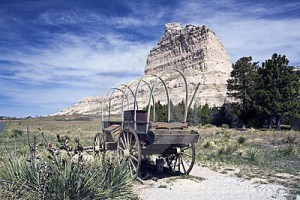
Photo on Oregon Trail, Scott’s Bluff, NE, supplied by LaDene Morton
But that list is about more than what to take. It’s about what you can make from what you have. The awl and buckskin turned saddle leather into shoes. The needle and thread mended and crafted scraps into quilts. Wagons were turned into rafts with a good slather of tar in the box. Broken bits of wagon carriage were carved into other useful tools.
I’ve often thought of the loneliness of those cast off bits of a life left behind as lonely sentinels along the trail. But after revisiting this, I see them now, too, as the natural castings of life. Most of life molts or sheds or breaks from a carapace to grow. Maybe, after all, those cast offs weren’t just sentinels of despair along the road, but milestones, too – milestones that marked the sacrifices they were willing to make to start that new life.
[1] Hastings, Lansford W., The Emigrants’ Guide to Oregon and California, George Conchlin Publishing, Cincinnati, 1845.
[2] Marcy, Randolph B. (Captain, US Army), The Prairie Traveler
***********************************************************************
LaDene is currently revamping her website, but she can be reached at ladmorton@aol.com. She has very generously agreed to send one paperback copy of What Lies West to a lucky person chosen randomly on or about the 25th November from comments .
What Lies West is set in the mid-nineteenth-century American frontier, where everyone is headed out in pursuit of a dream. Carolina Clark, the young widow of a ne’er-do-well overland trader, can’t afford to dream, thanks to the bankrupt business her late husband has left her. With no prospects, Lina is goaded into traveling west as well, with two unexpected partners, one a would-be madam, the other a want-to-be cavalryman. In the long journey west and the life she pieces together there, Lina slowly discovers that within her lies her own dream, a dream she never saw coming.


September 30, 2013
AND NOW FOR SOMETHING COMPLETELY DIFFERENT
Readers of this column will know that I generally write on topics pertaining to either the American West or literature, as do my frequent guests. But the title of the blog includes the words, “My World” and, as it happens, that in turn includes New York. There are numerous things about which I could write concerning New York but the one thing I like best is…the food!
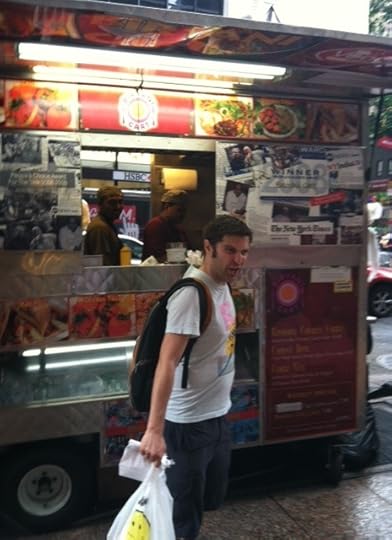
Tour guide Brian Hoffman in action
A couple of months back I was persuaded to take a food cart tour of the city. Now, I’m a gal who never, but never, eats on the street, and certainly never bought food from a food cart. I’d be too darn embarrassed to go about licking an ice cream cone, never mind stuffing my face with a hot dog or lunch from a cart. It wasn’t so much the thought of whether the food was garnering carcinogenics or was otherwise unhygienic, it was simply something I couldn’t bring myself to do. But when my daughter’s boyfriend’s birthday came up and I was faced with presenting him with something he’d actually like, this was the product of my ruminations. He LOVES food from a cart and here was a tour of the best in NYC.
Food carts evolved in New York from as early as the 1600s. If you could not afford a market stall, a pushcart to sell your wares was a popular way to make money, and food could be sold as easily as anything else this way. Oysters were most likely amongst the first items; they were plentiful at the time in the rivers around the city and therefore cheap, the food of the poor. As more immigrants poured into the city, more variety appeared on the carts: knishes, bagels, pastrami, sausages—which evolved into the hot dog—pickles, pretzels and nuts all began to make an appearance. Selling from a cart has always been an ideal way for immigrants to get a foot in the door;
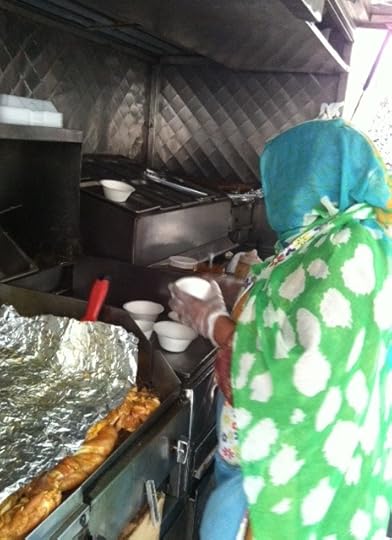
Trink Paki Boys preparing our lunch
with the high price of the city’s commercial rents, making and selling food from a cart has proven an excellent alternative to each new wave of immigrant bringing different types of food. It has the added bonus for office workers of also being a cheap and quick alternative to restaurant lunches.
For those who, like myself, have concerns over the cleanliness of the carts and the workers, let me tell you that the restrictions are more constraining than those for restaurants. Carts are inspected by the Department of Health with random examinations. Obviously, food must be fresh and can not be re-used. Each worker on the cart—not just the individual vendor or owner—must go through a two-day course on food handling and safety with an exam at the end of it. These individual licenses must be renewed every two years, as does the one for the vehicle. That costs $200 from the Department of Health—and no further licenses are currently being issued. This has, as one might expect, resulted in a market of ‘sub-letting’ the licenses, and rumor has it that the going rate is no less than $20,000 for two years!

Brian Hoffman with a mobile food vendor’s license
After all this, how do the carts find their spot? The City does not assign spots outside of the Parks or private property; all the locations are by gentleman’s agreement and no filching of spaces occurs. Vendors are up very early to collect their vehicles from special commissaries or garages, where they have been cleaned and stored overnight, and to prepare the food in a commercial kitchen. Often these areas are outside of Manhattan so the trek into the city awaits along with the set-up, not to mention the removal of the attached car that brought it there. This may mean going all the way back to one of the boroughs and the vendor coming back into Manhattan to his site by public transport. The hours each vendor works depends on the area; for instance, down around Wall St. where the financial district ‘closes’ at night, most vendors are there for lunch and gone by about four, as they are in the commercial heartland of midtown. In areas where there may be more bars, it won’t be unusual to find carts working into the wee hours of the morning, providing sustenance to late-night drinkers. But here’s the catch: all carts must go back to the commissary for a clean-up once within every twenty-four hours.
So, what was the tour like and, most importantly, what is the food like?
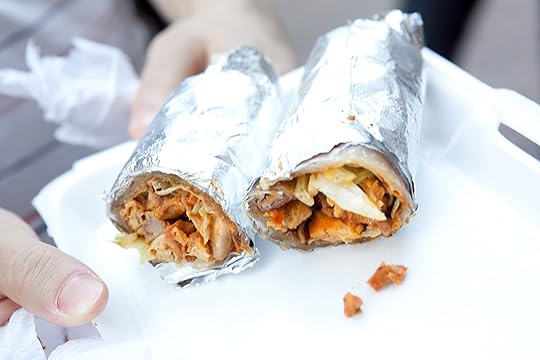
Kati Rolls from the Biryani Cart, photo courtesy of Jennifer Strader
We went with Turnstile Tours and our guide was Brian Hoffman. Hoffman is young, energetic and highly enthusiastic about New York food, and it rubs off on his clientele. My cohorts and I had chosen the midtown tour (there is another food cart tour down in the financial district) and Brian started the tour with a brief history before leading us on to Trini Paki Boys at 43rd St. and 6th Ave. It was lunch time for tour members and we started with a chicken over rice dish from this vendor who’s been selling halal food on the streets for twenty-five years. Next stop was award-winning kati rolls from the Biryani cart also at 46th St. When I say award-winning, yes, there are Vendy Awards organized by the Street Vendors Project for the best foods from street carts. Nominees are chosen by the public throughout the year and the final decision is made by a panel of judges; the ceremony takes place in September. Back on the tour, we had falafel from a Bengali chef who used to work at the Russian Tea Room. Now, I have to say falafel is not one of my favorite foods; I usually find it dry and tasteless. This falafel, however, was moist and delicious and left me wanting more. Other stops included quesadillas from El Rey del Sabor, Korean food from Bapcha and a grand finale of Belgian waffles from Wafels and Dinges.
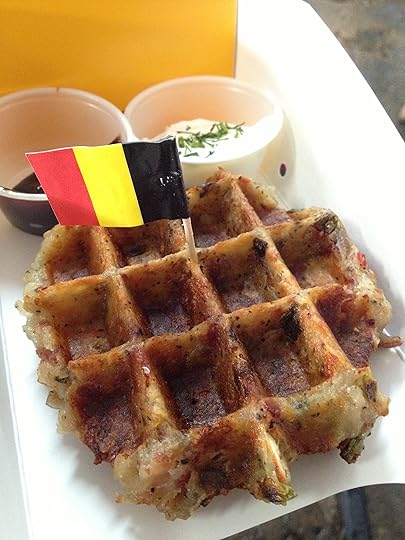
Waffles from Wafels and Dinges, photo courtesy of Andrew Gustafson
We were also blessed with a treat from the now famous Treat Truck,
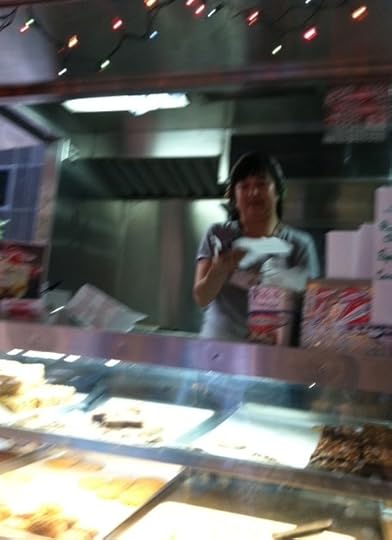
The Treat Truck
which has been featured on several television programs.
I can’t say whether I am any less reluctant to be seen eating on the street, but I do know one thing: if I ever get hungry while walking the mean streets of New York and can find a lovely park bench nearby, there’ll be a really delicious meal waiting for me from a cart in the area.
***********************************************************************
My sincere thanks to Brian Hoffman for his help in the preparation of this article…not to mention an exciting day out. You can find Brian and his take on New York food at http://www.eatthisny.com/ and on Facebook at https://www.facebook.com/pages/Eat-This-NY/209449281899 and you can follow his tweets at @EatThisNY
Turnstile Tours is at http://turnstiletours.com
AND EVERYONE WHO LEAVES A COMMENT WILL RECEIVE A SMALL GIFT!



